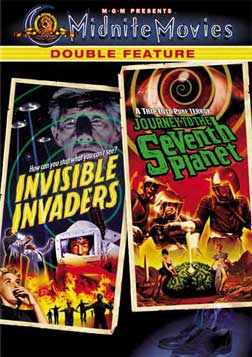 INVISIBLE
INVADERS (1959)/JOURNEY TO THE SEVENTH PLANET
(1962)
INVISIBLE
INVADERS (1959)/JOURNEY TO THE SEVENTH PLANET
(1962)Directors: Edward L. Cahn, Sidney Pink
MGM
 INVISIBLE
INVADERS (1959)/JOURNEY TO THE SEVENTH PLANET
(1962)
INVISIBLE
INVADERS (1959)/JOURNEY TO THE SEVENTH PLANET
(1962)INVISIBLE INVADERS
INVISIBLE INVADERS, the brainchild
of prolific director Edward L. Cahn, was yet another apocalyptic rendering of
"alien race taking over the bodies of the dead on earth" theme. At
the time of its release in 1959, this angle--while not fresh and new--hadn't
become totally cliché. But the premise was well on its way to being hackneyed
and stale.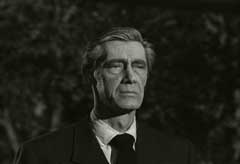
In order to accomplish the takeover of Earth, these intergalactic troublemakers blow scientist Dr. Carl Noymann to kingdom come and then utilize his body as a host. John Carradine portrays the venerable scientist with cornstarched hair, gray skin pallor and more lines on his face than a roadmap. As our dear departed scientist was blown to bits, one is at a loss to understand how he was ever put back together but logic, as usual, be damned! The shoestring budget of this production is immensely aided by the fact that the threat from outer space is mostly unseen. There is also abundant use of stock footage of explosions and fires, two methods of dispatch favored by The Enemy.
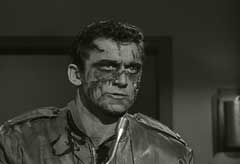 There
is some otherworldly atmosphere going here and a creepy score by Paul Dunlap
(a regular United Artists in-house composer) which certainly helps things along.
There is also a well-dressed cemetery on a soundstage near the start of INVADERS
and this opus is graced with Carradine's presence, which is somewhat restrained
for a change.
There
is some otherworldly atmosphere going here and a creepy score by Paul Dunlap
(a regular United Artists in-house composer) which certainly helps things along.
There is also a well-dressed cemetery on a soundstage near the start of INVADERS
and this opus is graced with Carradine's presence, which is somewhat restrained
for a change.
The late John Agar lends his boyish
good looks and heroic demeanor to the proceedings too. This reviewer encountered
him dozens of times at autograph signings in Los Angeles and found him to be
very kind and accommodating to all the fans who wanted his signature on everything
from TARANTULA one-sheet posters to still photographs. In retrospect the surprise
this reviewer had regarding Agar was how very short he was! 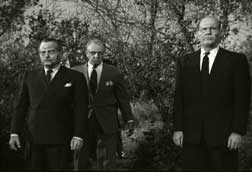
George Romero is heavily indebted to this film and LAST MAN ON EARTH. They basically set forth the blueprint which made cinema history with the release of his 1968 chef d'ouevre NIGHT OF THE LIVING DEAD. There is also homage to Howard Hawks THE THING near the film's end.
1950s audiences probably found some shock value with INVISIBLE INVADERS. The film is a brisk 67 minutes in length and was shot full-screen and in black and white. The theatrical trailer is included and INVADERS has 16 chapters. English, French and Spanish subtitles are available as well.
INVISIBLE INVADERS, in spite of itself, is enormously fun and well worth owning.
JOURNEY TO THE SEVENTH PLANET
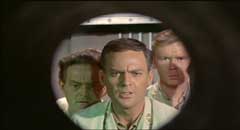 This
Scandinavian entry in the science-fiction sweeps of the 60s came to fruition
though the combined efforts of Director Sidney Pink and Danish Writer Ib Melchior.
This
Scandinavian entry in the science-fiction sweeps of the 60s came to fruition
though the combined efforts of Director Sidney Pink and Danish Writer Ib Melchior.
The story begins with a narrator speaking as a rocket prepares to lift off.
"There are no limits to the imagination. And man's ability to make reality out of his visions is his greatest strength. Through this skill he has been able to conquer time and space. The story you are about to see takes place after man has solved the complex mysteries of space travel. The year is 2001. Life is changed now. The planet Earth is no longer wracked by wars and threats of annihilation. Man has learned to live with himself."
The countdown ends and the rocket is off!
"The United Nations is
the sole governing body of the world and the great hunger now is for knowledge.
All the planets near the sun including Saturn have been explored and chartered
by the UN Space Fleet. But as yet no sign of life in any form has been discovered.
The search goes on, and systematic exploration continues. Spaceship Explorer
12 is now on a mission to survey, land and investigate the seventh planet, Uranus."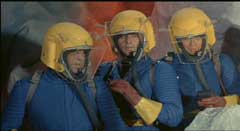
The five astronauts are Captain Don Graham (John Agar), Commander Eric Nilsson (Carl Ottosen of REPTILICUS fame), Barry (Ove Sprogoe), Svend Viltoft (Louis Miehe Renard) and Lt. Karl Heinrich (Peter Monch). They have no idea their lives will be irreversibly altered as they speak about their favorite topic: the women in their lives.
We are introduced to a bevy of European beauties starting with Greta Thyssen, and a host of other seductresses. As Captain Graham blithely remarks of one of his conquests, "She was German, a biological expert. And was she biological!" All of the men aboard the Explorer 12 are well on their way to temptation, danger and a wild ride to nearly the end of the Solar System!
An evil force dominates Uranus,
a gigantic brain that emits wavelengths which cause the astronauts to hallucinate
their greatest fears and most cherished desires. First, the frozen nitrogen/ammonia
atmosphere and foreboding Uranusian landscapes 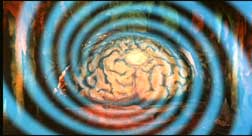 transform
into idyllic Scandinavian forests with cabins and campfires. Our spacemen encounter
some really sexy female companionship in the form of six lovelies. To further
manipulate the men with fear the omniscient brain-force makes a giant spider
and a one-eyed dragon appear and menace them.
transform
into idyllic Scandinavian forests with cabins and campfires. Our spacemen encounter
some really sexy female companionship in the form of six lovelies. To further
manipulate the men with fear the omniscient brain-force makes a giant spider
and a one-eyed dragon appear and menace them.
By today's standards the special
effects are somewhat dated however one has to consider that all of this looked
pretty good back in 1962. The Cyclops-dragon isn't exactly Harryhausen in the
quality department (keeping everything in perspective of that day) but the efforts
are amazing nonetheless, particularly given a less than generous budget. There
is a giant spider attack which appears to be color (or perhaps tinted frames)
from AIP's earlier EARTH VS. THE SPIDER (1958) but his appearance in a cavern
on Uranus was pretty strong stuff back then.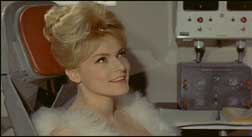
This reviewer has met the famed Ib Melchior and a Danish friend, Nicholas Barbano, stayed at the Melchior home in Hollywood during a visit to Los Angeles. He noted that Mr. Melchior indeed had many props to this very day from these productions.
The late and celebrated Sid Pink was mainly responsible for JOURNEY, and he and Melchior wrote the screenplay based on Pink's original story.
Astute listeners may recognize
music tracks in JOURNEY that had been utilized in other American-International
product. As John Agar falls into an ice pit (referred to as "quick ice")
the music is definitely that of the late Ronald Stein and is recycled from Roger
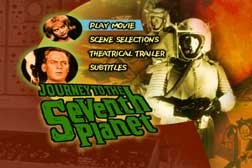 Corman's
1957 hymn to reincarnation, THE UNDEAD! Additionally the song "Journey
to the Seventh Planet" by Jerry Capehart and Mitchell Tableporter with
the velvet voice of crooner Otto Brandenburg is restored here (during the film's
end credits). Otherwise the original music score by Ib Glindemann, itself a
dreamlike passage into the dark regions of the solar system, concludes the film.
The replacement of the title song is an unforgettable memory from the early
60s and is yet another treat courtesy of MGM. Colors (by Cinemagic, Inc.) are
vibrant and especially rich in JOURNEY. The spacesuits are eye candy in themselves
with electric blues, neon reds and phosphorescent yellows. The terrain and landscapes
for the most part are equally rich throughout and employ all colors in the spectrum.
Corman's
1957 hymn to reincarnation, THE UNDEAD! Additionally the song "Journey
to the Seventh Planet" by Jerry Capehart and Mitchell Tableporter with
the velvet voice of crooner Otto Brandenburg is restored here (during the film's
end credits). Otherwise the original music score by Ib Glindemann, itself a
dreamlike passage into the dark regions of the solar system, concludes the film.
The replacement of the title song is an unforgettable memory from the early
60s and is yet another treat courtesy of MGM. Colors (by Cinemagic, Inc.) are
vibrant and especially rich in JOURNEY. The spacesuits are eye candy in themselves
with electric blues, neon reds and phosphorescent yellows. The terrain and landscapes
for the most part are equally rich throughout and employ all colors in the spectrum.
According to the pressbook for this film, JOURNEY's duration was originally 80 minutes and a Variety review reported it at 82 minutes. This reviewer definitely recalls still photographs showing one of the astronauts in full spacesuit with bones for legs and feet, though this may have been footage that was never used or was dropped.
MGM's transfer for JOURNEY is splendid, with bright colors and a clean image, and it's letterboxed at 1.66:1. Audio quality is also up tp par. There are 16 chapter stops and a theatrical trailer is included. There are English, French and Spanish subtitle options.
JOURNEY TO THE SEVENTH PLANET is magnificent, a treasured memory from the 60s and alone is worth the price of the disc. This double-bill is a winner all the way, a cherished treat in the Midnite Movies Series from MGM. (Christopher Dietrich)